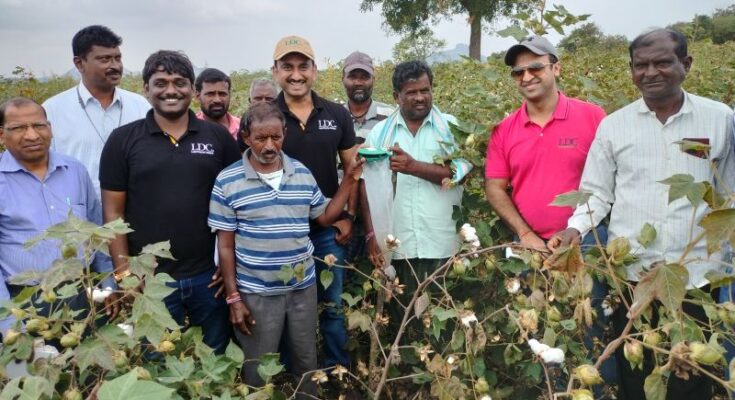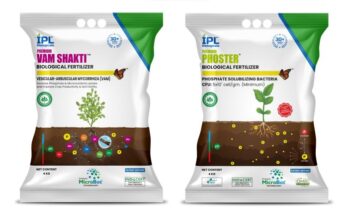Nearly two kilometres from Damera village in the Hanamkoda district in Telangana, 20 cotton growers were gathered to take stock of the current status of their blossoming cotton in their fields. Ganga, Batthi Reddy, Kumar Swamy, Madaram Kankiya, Dikshapal, Yogeshwaran, Mohan Rao, Ravindra Reddy, and D Chinnapedi were marginal farmers with one to eight-acre land where they grow cotton. Thanks to Bt-1 and 2, their yield has increased significantly and they were getting a reasonable price (above than minimum support price) in the market. But their main pain point now is pests, especially pink bollworm (PBW) which is an insect known for being a devastating pest in cotton farming. Cotton growers here are trying hard to overcome the challenge.
Small farmers, with 14 to 30-acre cotton fields, came from nearby Narmeta village located in the neighbouring Jangaon district. From Narmeta, educated cotton grower Velangal Reddy with 30 acres of land was equally concerned about the attack of pink bollworm. His fellow villagers G Bala Subha Reddy and D Chimapeddi with 14-acre cotton fields each recalled the previous years when their fields were heavily attacked by pink bollworms and they were helpless and did not know to prevent their crops from PBW. A visit to the cotton fields of Telangana explains not only the main points of the growers but also the interventions that are giving positive outcomes in terms of preventing the loss due to pest attacks.
Agricultural fields in areas surrounding Damera and other villages in the Hanamkonda and Jangaon districts in the Warangal region of Telangana were blossoming with cotton crops and growers feel that this season would fetch them a better price with enhanced yield compared to previous years. Pest threats to cotton crops were minimised by the intervention of Project Jagruthi, launched by Louis Dreyfus Company (LDC) – a French Company working in the agriculture and food sectors.
It is nearly two decades now since Bt Cotton was introduced in India. It is claimed that it transformed the ways India does its cotton farming. Cotton growers of Damera and Narmeta say that they are still facing pest breaks like bollworm. Interventions of LDC, with awareness workshops and distribution of pheromone trappers, have helped them a lot but there is certainly a need for new technology for cotton seeds.
You may also like to read – India conducts largest field experiment of ‘mating disruption’ technology to combat pink bollworm in cotton
Velangal Reddy, an educated cotton grower from Nermeta village who cultivates cotton on his 30 acres, looked very disappointed with the way India deals with GM technologies. He says, “We are using all GM edible oils and other things, imported from outside, but here in India there is a strong lobby against it. We are not only facing pink bollworm but labour shortage also due to the government welfare schemes. The younger generation is ready to work outside but not in the fields even though they have 30 acres of land. The government should provide newer technologies to us as par with the US and other developed countries. If we can use Bt cotton oil, then what is the harm of using other GM crops and products? LDC’s Project Jagruthi has helped us a lot in terms of prevention against pink bollworm, but the point is we need newer technologies in seeds.”
Pink bollworm is now the main concern and it causes huge damage to the cotton crop across India. Following the pink bollworm outbreak in 2021, LDC launched ‘Project Jagruthi‘ for cotton growers in India.
“We have trained over 7,500 farmers in over 30 villages in Punjab, Haryana, Rajasthan, Gujarat, Maharashtra, Telangana, Karnataka, and Andhra Pradesh through workshops. In addition, we provided over 40,000 pheromone traps to the farmers so far. In northern states, we have distributed 17,000 traps whereas in Central and South India including Telangana 23,000 traps have been given to cotton growers. We aim to further increase this in the next season. In Damera, we organised an awareness camp and distributed eight traps per acre. Nearly 250 farmers benefitted under the project and as awareness and yield increased, cotton growers of 17 villages in the region now come forward for traps. They are even requesting LDC to impress upon agents in the market to provide them with the traps and they are ready to buy it,” says Sumeet Mittal, Cotton Platform Head-India, LDC.
Dikshapal, a marginal cotton farmer (4 acres) in Damera village and one of the 250 beneficiaries of Project Jagruthi, was in an upbeat mood as his yield increased with the use of a pheromone trap in the field. “In the 2021 season, with the pink bollworm attack, I was able to get only five quintals per acre of cotton. This year I am expecting over eight quintals of cotton which is a significant increase,” he says. Similarly Mohan Rao, Ravindra Reddy, Yogeshwaran and other fellow villagers got a 30-40 per cent increase in the yield. Reddy is also expecting nine quintals of cotton per acre. Last year, the yield was limited to about six quintals per acre due to the pink bollworm menace which gives cotton growers nightmares.
You may also like to read – Project Bandhan: Protecting cotton production from Pink Bollworm
It was admitted by the cotton growers of Telangana that awareness and pheromone traps have significantly increased per acre yield. Mergu Rajkumaraya, who has been cultivating cotton for nearly 20 years, says the cost of cultivation is increasing due to rising pesticide, fertiliser and labour costs, which are exacerbated by pink bollworm.
Each cotton-growing state such as Gujarat, Rajasthan, Maharashtra, Andhra Pradesh, Telangana, Punjab, and Karnataka is by and large has been affected by pink bollworm which affected the yield in Gujarat hugely in 2014. “In Telangana, we witness the menace in the 2016-17 season. Pink bollworm damages the crop by 5 per cent if it attacks late but at an early stage, attack damage can be 30-40 per cent. There are three stages of pink bollworm- Lieur, Mouths and the final stage is known as a worm which causes the loss. With pheromone traps, we try to stop the mating of male and female mouths. Another advantage of the trap is that it gives an indication and severity of pink bollworm attack, accordingly, we can plan the quantum of pesticides to be used in the field,” explains Gangadhara S, Senior Manager- Research, LDC.
Gangadhara says that mass trapping is an effective solution to overcome the challenge of the pest attack and for this, all growers need pheromone traps. “Along with awareness workshops, LDC is making all efforts to distribute a large number of traps so that they reach the maximum number of cotton growers in Telangana,” he adds.
Is prevention with a pheromone trap the only solution? To prevent massive loss due to pest attacks, Bt Cotton seed companies give some non-Bt seeds to the growers to be used in the field. Due to a lack of awareness about its efficacy and being yield conscious farmers usually do not use non-Bt seeds, hence sometimes, early identification of pink bollworm is delayed.
You may also like to read: Corteva Agriscience launches Novixid herbicide to tackle weeds in rice crops
Along with prevention, other experiments are on. High-Density Planting System (HDPS) in cotton has been showing positive outcomes in experimental stages. HDPS is being done extensively at Professor Jayshankar Telangana State Agriculture University (PJTSAU), Hyderabad.
Dr B Anil Kumar, Senior Scientist, PJTSAU, takes care of 11 districts of Telangana with training and awareness camps. He moves from village to village on daily basis to train farmers with the best practices.
“In a conventional method, we sow 5,500 plants in the given 120 cm space and a gap of 60 cm in black soil. Similarly, in red soil, we sow 14,500 plants in a 90X30 space. But in HDPS, 25,000 plants are placed in a 90X20 formula. We have seen a significant increase in yield from nine quintals per acre to 15 quintals per acre. It is very effective in red soil,” says Dr Kumar.
On pink bollworm, he says since the last five years Telangana has been witnessing its menace and it damages the quality of crops. “The state government has been providing subsidies of Rs 4,000 per acre to farmers and equipping them with new technologies. For example, we are providing pneumatic planters to cotton growers. With this plant a farmer can sow one acre with HDPS in half-hour,” informs Dr Anil Kumar who strongly recommends crop rotation (maize in January) for Telangana farmers to overcome the pain points like pink bollworm. According to him, in Telangana with three agro-climatic zones, cotton season begins with the first round of sowing in May and by December season gets over.
In nutshell, till India gets other advanced tech-enabled pest-resistant seeds, only prevention and smart farming can help cotton farmers of Telangana. LDC has shown them the way and they need to follow the training tips and fetch pheromone traps from markets if the company is not able to cover all the farmers of the state.





